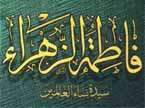Hadith of Fatima tablet

Hadith of Fatima tablet, also known as the Hadith of Lowh of Fatima is a tradition of Imam al-Sadiq who narrated his father Imam al-Baqir who in turn quoted Jabir ibn Abdullah as the original narrator of the hadith. This hadith specifically names twelve Imams as successors to Muhammad, prophet of Islam.[1]
Jabir ibn Abdullah
Jabir ibn 'Abdullah ibn 'Amr ibn Haram al-Ansari was a prominent companion of Muhammad, the prophet of Islam, and the subsequent Shia Imams. He delivered the greeting of the prophet to his second great-grandson, Muhammad al-Baqir.[2] Jabir took part in eighteen campaigns headed by the prophet and fought in the Battle of Siffeen led by Ali ibn Abi Talib.[2][3]
Background
On the birth of Husayn ibn Ali, prophet gave Fatima a tablet. Jabir described the tablet by following words:
| “ | "I saw a green tablet in her hand made of green aquamarine (emerald). There was some writing on it with a light that was brighter than the sun and (the tablet) smelled better than musk.[4] | ” |
Jabir asked Fatima about the tablet. Fatima said that it is a gift from Allah to prophet that was sent by Angel Gabriel. He gave it to me so that my heart feels happy and pleased whenever I look at it. It contains the names of the Prophet, and Ali ibn Abi Talib, Hasan and Husayn as successors after him. He said, I asked Lady Fatima to give the tablet to me so I can read its inscription and make a copy of it. After the years, one day, Imam al-Baqir said to Jabir that I have to meet you privately. When Imam was alone with Jabir, he asked him about the tablet of Fatema. Jabir answered "Yes" and brought it for Muhammad al-Baqir from his house.[4]
In Kitab al-Kafi, Jabir narrates that he once saw Fatima with a tablet listing the names of those with divine authority, which he counted to be twelve. The last one was named Al Qa'im, three were named Muhammad and three were named Ali. [5].
The Hadith
This hadith was narrated by Seyyid Sharaf al-Deen al-Najafi from Moqallad bin ghalib al-Hasani from Abdillah bin Sinaan al-Asadi from Ja'far al-Sadiq. Also, Ja'far al-Sadiq narrated it from his father. The hadith introduces Ali and his sons as successors to the Islamic Prophet[4]
Imam Sadiq narrated the hadith as following:
| “ | "My father said to him: "Look at your copy to see (if) what I say (matches your copy)." This is what was written on that tablet: "In the name of Allah, most Gracious, most Merciful. This is a letter from Allah, the most Honourable, the most Knowledgeable, which was sent with the guardian spirit to Muhammad, the last of the messengers. O Muhammad! Glorify My names, be thankful for My grace, and do not deny My blessings. Do not desire anyone but Me and do not fear anyone but Me, because those who desire anyone but Me or fear anyone but Me will be punished in a way that I have never punished anyone else from all of the worlds. O Muhammad! I have chosen you from amongst all of the prophets and I have given preference to your successor above all of the successors. I have made Hasan the container of My Knowledge after the time of his father, and (I have made) Husayn the best of the sons from the first to the last, and through Husain the Imamate will continue. Ali, the beauty of the worshippers, will remain from Husain, and then (it will be) Muhammad, the one who rips open My Knowledge, the one who will invite (people) to My path through the right methods. Then (it will be) Jaafar, the truthful in his speech and his actions, after whom there will be a deafening conspiracy. Woe and more woe unto those who deny My slave and the best of My creation, Musa! Then Ali, the pleasant, will be killed by a Kafir demon, and he will be buried in the city that was built by the righteous slave, next to the worst of Allah’s creation (the worst of creation refers to Harun al-Rashid, the killer of Imam Musa ibn Ja'far). Then Muhammad (will come), the guide to My path, the one who safeguards My sanctity, and the one who will leave Ali behind. Ali will be the one with two names (Ali and Naqi). After him, Hasan, the honourable, will lead his people. And after him his son, Muhammad, will rise at the end of time. There will be a white cloud over him to offer him shade from the sun. He will speak with an eloquent language and his voice will reach everyone and everywhere. He is the Mahdi of the family of Muhammad and he will fill the earth with justice, just as it's been filled with injustice."[4] | ” |
Reception
The Hadith of Fatima tablet is mentioned in shia and sunni hadith sources including Kamal al-din wa tamam al-ni'mah of Al-Shaykh al-Saduq, Kitab al-Kafi of Muhammad ibn Ya'qub al-Kulayni, Al-Istibsar of Shaykh Tusi, al-Musnad of Ahmad ibn Hanbal, Sahih al-Bukhari of Muhammad al-Bukhari, Sunan ibn Majah of Ibn Majah.[6]
See also
References
- ↑ Linda G. Jones (6 August 2012). The Power of Oratory in the Medieval Muslim World. Cambridge University Press. pp. 237–. ISBN 978-1-139-53680-6.
- 1 2 Dr. S. Manzoor Rizvi. The Sunshine Book. Lulu.com. pp. 176–. ISBN 978-1-312-60094-2.
- ↑ Abu Shahba, Jerrmein. "Jabir Ibn Abdullah Al Ansari – The 1st Narrator". Al-Islam.
- 1 2 3 4 The Qaem in the Quran. Shiabooks. 2006. pp. 84–. ISBN 978-0-9781478-0-8.
- ↑ Al-Kulayni, Abu Ja’far Muhammad ibn Ya’qub (2015). Kitab al-Kafi. South Huntington, NY: The Islamic Seminary Inc. ISBN 9780991430864.
- ↑ Torkamani, Hussain Ali (1376). "Hadith of fatima tablet and interpretation of it". Hadith Science. 6: 14.